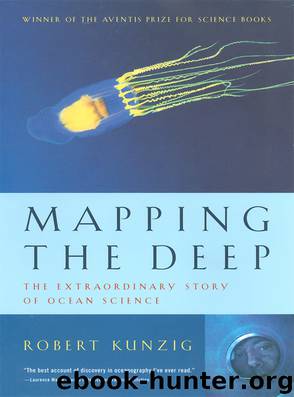Mapping the Deep by Robert Kunzig

Author:Robert Kunzig
Language: eng
Format: epub
Publisher: W. W. Norton & Company
Rosacea flaccida, a siphonophore that grows to about 10 feet long, lets down its tentacles to form a large “fishing net” .
No one really knows what the right conditions are, why salp swarms occur in some times and places and not others. But one thing that seems to keep a salp population in check, paradoxically, is too much food. Harbison and Gilmer first noticed the phenomenon while diving in the 1970s and later confirmed it with laboratory experiments. When a salp encounters water that is too rich in plankton, it chokes. A bolus of food and mucus lodges in its oesophagus like a poorly chewed ham sandwich, and while the animal can sometimes dislodge the obstruction by a kind of tunicate Heimlich manoeuvre, swimming backwards and blowing the whole mucous net out its front end, often that manoeuvre fails. A salp with a blocked oesophagus, unable to feed though it be floating in lunch, is not a happy salp. “The few clogged salps we have seen in the field appeared to be in poor condition,” Harbison and Gilmer wrote.
Clogged salps are fairly rare in the field, Harbison thinks, because salps steer clear of danger zones. With the exception of a few species, they avoid the rich coastal waters – they live far from shore, which is why they are so unfamiliar to most of us. With their delicate vacuum cleaner of a feeding apparatus, they are especially adapted to life in the open ocean. Where food is plentiful, they starve; where it is small and scarce, they thrive. Salps like it out there.
Download
This site does not store any files on its server. We only index and link to content provided by other sites. Please contact the content providers to delete copyright contents if any and email us, we'll remove relevant links or contents immediately.
The Lonely City by Olivia Laing(4772)
Animal Frequency by Melissa Alvarez(4430)
All Creatures Great and Small by James Herriot(4272)
Walking by Henry David Thoreau(3926)
Exit West by Mohsin Hamid(3796)
Origin Story: A Big History of Everything by David Christian(3666)
COSMOS by Carl Sagan(3592)
How to Read Water: Clues and Patterns from Puddles to the Sea (Natural Navigation) by Tristan Gooley(3434)
Hedgerow by John Wright(3319)
How to Read Nature by Tristan Gooley(3294)
The Inner Life of Animals by Peter Wohlleben(3285)
How to Do Nothing by Jenny Odell(3264)
Project Animal Farm: An Accidental Journey into the Secret World of Farming and the Truth About Our Food by Sonia Faruqi(3191)
Origin Story by David Christian(3170)
Water by Ian Miller(3157)
A Forest Journey by John Perlin(3044)
The Plant Messiah by Carlos Magdalena(2900)
A Wilder Time by William E. Glassley(2837)
Forests: A Very Short Introduction by Jaboury Ghazoul(2815)
